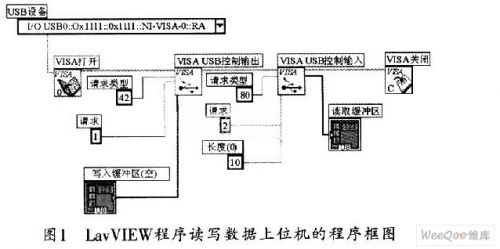0 Preface
The CY7C68013 integrates an enhanced 8051 microcontroller and an I2C-compatible controller with transmission rates up to 100 kHz or 400 kHz. LabVIEW is a software for designing virtual instruments based on a graphical language. LabVIEW uses a graphical block diagram to build program code. The LabVIEW program is driven by the data stream, and the data flow controls the execution order of the program. LabVIEW is a powerful general-purpose programming system with an extensible library and subroutine library. Its Virtual Instrument Software Architecture (VISA) is an advanced application programming interface (API) for communicating with various instrument buses. Limited by platform, bus and environment.
The I2C (Inter-Integrated Circuit) bus is a two-wire serial bus developed by Philips to connect microcontrollers and their peripherals. It consists of a data line SDA and a clock SCL for transmitting and receiving data. Its main advantage is simplicity and effectiveness.
In general, the software of a complete USB communication system usually requires three parts: the host computer program, the driver program and the firmware program.
1 PC program development
The NI LabaxIEW is used to realize the development of the host computer program, and the control transmission mode can be adopted during the development. The control transfer uses the function "VISA Open" to open the specified USB device, while the "VISA USB Control Output" function is used to complete the definition request 0xBl, which writes the data in the "write buffer" to the FPGA registers. Use the function "VISA USB Control Input" to complete the custom request 0xB2 and read the data in the FPGA registers back into the "read buffer". Its block diagram is shown in Figure 1.

When the waveform is set in the upper computer program, the function of pop-up window can be generated by the sub-VI to realize the setting of the program channel, and the sub-VI generated by the arbitrary waveform can be realized by the event structure, the case structure and the loop structure; SubVI design for basic waveform settings.
2 driver development
You can use NI VISA to develop drivers. When performing USB communication, VISA provides two types of functions for LabVIEW calls, namely USB INSTR devices and USB RAW devices. The USB INSTR device is a USB device that complies with the USBTMC protocol. When using the USB INSTR function, the communication does not need to be configured with NI-VISA. The USB RAW device refers to any USB device other than the device that clearly conforms to the USBTMC specification. Have to configure NI-VISA. For detailed steps and procedures for configuring NI-VISA, refer to the free NI-VISA Control USB Device on NI*****.
3 firmware development
There are about five documents that need to be modified to form the construction. Fw.c is the main file of the USB firmware program. In order to realize the control transfer, the file needs to be modified: one is to declare two functions for responding to the custom device request, and the other is to set the response part of the custom device request. .
Periph. c First set the initialization function TD_Init(void), and set the register associated with the EPOBUF, the clock frequency of the CPU, and the I2C-related registers: second, define the function used to respond to the custom device request.
Fx2. A custom request is defined in the h header file.
Dscr. In a51, you need to set the device descriptor and configuration descriptor, as well as the interface descriptor. The O endpoints needed to control the transfer do not need to be set.
Syncdly. In h, set the register of the initialization function TD_Init(void).
The read and write functions of the I2C bus to be used in the examples described in this article are as follows:
The first is: EZUSB_WriteI2C (BYTE addr, BYTE length, BYTE xdata*dat), where addr is used to specify the I2C device address; length is the transfer data length; *dat is the start address of the send data buffer: this function can be used to EZ - USB I2C interface writes a string of data. This function returns immediately before all provided data is sent. If data is currently being sent or received, FALSE is sent back and the data is not sent. If the port is not busy, the data enters the queue and returns TRUE.
The second function is EZUSB_ReadI2C (BYTE addr, BYTE length, BYTE xdata*dat), where addr specifies the I2C device address; length is the transfer data length; *dat is the receive data buffer start address; this function is used from EZ - The USB I2C interface reads a string of data. This function returns immediately before all requested data is read into the buffer. Users need to constantly ask for the status of the I2C to determine when the data is valid. If the data is currently being sent or received, FALSE is returned when the function is called, and the data is not read. When the I2C port is not busy, the data queue is read and TRUE is returned. 

Insulation Paper,Electrical Insulation Paper,Paper Backed Insulation,Recycled Paper Insulation
Longkou Libo Insulating Material Co.,Ltd. , https://www.liboinsulation.com
